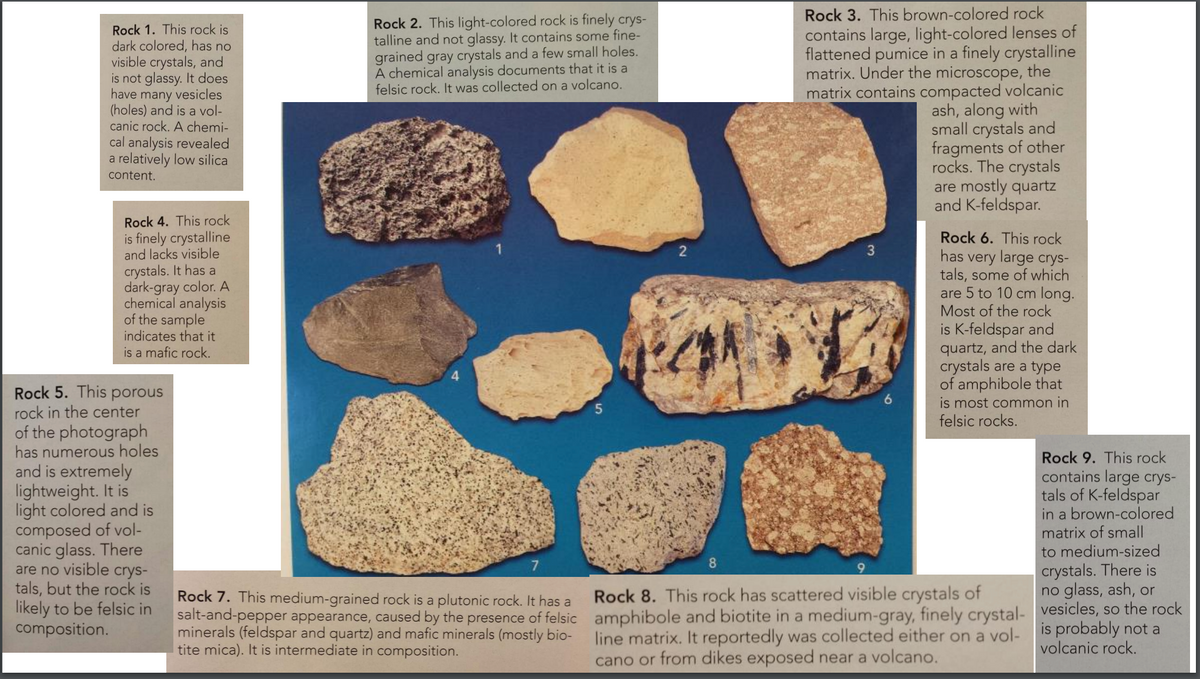What is the most likely cause of initial melting at Site D? A) Temperature Increase B) Pressure Decrease C) Addition of Volatiles
What is the most likely cause of initial melting at Site D? A) Temperature Increase B) Pressure Decrease C) Addition of Volatiles
Applications and Investigations in Earth Science (9th Edition)
9th Edition
ISBN:9780134746241
Author:Edward J. Tarbuck, Frederick K. Lutgens, Dennis G. Tasa
Publisher:Edward J. Tarbuck, Frederick K. Lutgens, Dennis G. Tasa
Chapter1: The Study Of Minerals
Section: Chapter Questions
Problem 1LR
Related questions
Question
What is the most likely cause of initial melting at Site D?
A) Temperature Increase
B) Pressure Decrease
C) Addition of Volatiles

Transcribed Image Text:Rock 3. This brown-colored rock
Rock 1. This rock is
dark colored, has no
visible crystals, and
is not glassy. It does
have many vesicles
(holes) and is a vol-
canic rock. A chemi-
Rock 2. This light-colored rock is finely crys-
talline and not glassy. It contains some fine-
grained gray crystals and a few small holes.
A chemical analysis documents that it is a
felsic rock. It was collected on a volcano.
contains large, light-colored lenses of
flattened pumice in a finely crystalline
matrix. Under the microscope, the
matrix contains compacted volcanic
ash, along with
small crystals and
fragments of other
rocks. The crystals
are mostly quartz
and K-feldspar.
cal analysis revealed
a relatively low silica
content.
Rock 4. This rock
is finely crystalline
and lacks visible
crystals. It has a
dark-gray color. A
chemical analysis
of the sample
indicates that it
is a mafic rock.
Rock 6. This rock
2
has very large crys-
tals, some of which
are 5 to 10 cm long.
Most of the rock
is K-feldspar and
quartz, and the dark
crystals are a type
of amphibole that
is most common in
felsic rocks.
4
Rock 5. This porous
rock in the center
of the photograph
has numerous holes
and is extremely
lightweight. It is
light colored and is
composed of vol-
canic glass. There
are no visible crys-
tals, but the rock is
likely to be felsic in
composition.
Rock 9. This rock
contains large crys-
tals of K-feldspar
in a brown-colored
matrix of small
to medium-sized
7.
8.
crystals. There is
no glass, ash, or
Rock 7. This medium-grained rock is a plutonic rock. It has a
Rock 8. This rock has scattered visible crystals of
salt-and-pepper appearance, caused by the presence of felsic amphibole and biotite in a medium-gray, finely crystal- vesicles, so the rock
minerals (feldspar and quartz) and mafic minerals (mostly bio-
tite mica). It is intermediate in composition.
line matrix. It reportedly was collected either on a vol- is probably not a
cano or from dikes exposed near a volcano.
volcanic rock.
![Site D: A continental magmatic arc,
where volcanoes are on top of a
mountain belt nearthe edge ofthe
continent. The volcanoes erupt light-
colored and gray volcanic rocks.
Older intrusive rocks, some with
coarse crystals, are also exposed.
[Samples 5,6, and 7]
Site A: A line of volcanic
islands and submarine
mountains. Broadvolcanoes on
the islands are foming dark
volcanic rocks. [Sample 1].
Site E: An island arc,
Site B: Circular
volcanic depressions
(calderas) on land,
which are filled with
light-colored volcanic
ash and light-colored
volcanic rocks.
which is a chain of
volcanic islands
adjacent to an ocearic
trench. The volcanoes
erupt gray volcanic
ash andlava flows.
There are also some
[Samples 2 and 3]
intrusive rocks.
[Samples 8 and 9]
Site C: A mid-oceanridge that zigzags across the ocean floor. The rock sample
is dark colored andis from a lumpy lava flow on the seafloor. [Sample 4]](/v2/_next/image?url=https%3A%2F%2Fcontent.bartleby.com%2Fqna-images%2Fquestion%2F7ca874b9-cbf0-443e-b65b-4d9e35817072%2Fe6429ccd-844f-4f22-8eae-05b0a831c8ef%2Ffh819ga_processed.png&w=3840&q=75)
Transcribed Image Text:Site D: A continental magmatic arc,
where volcanoes are on top of a
mountain belt nearthe edge ofthe
continent. The volcanoes erupt light-
colored and gray volcanic rocks.
Older intrusive rocks, some with
coarse crystals, are also exposed.
[Samples 5,6, and 7]
Site A: A line of volcanic
islands and submarine
mountains. Broadvolcanoes on
the islands are foming dark
volcanic rocks. [Sample 1].
Site E: An island arc,
Site B: Circular
volcanic depressions
(calderas) on land,
which are filled with
light-colored volcanic
ash and light-colored
volcanic rocks.
which is a chain of
volcanic islands
adjacent to an ocearic
trench. The volcanoes
erupt gray volcanic
ash andlava flows.
There are also some
[Samples 2 and 3]
intrusive rocks.
[Samples 8 and 9]
Site C: A mid-oceanridge that zigzags across the ocean floor. The rock sample
is dark colored andis from a lumpy lava flow on the seafloor. [Sample 4]
Expert Solution
This question has been solved!
Explore an expertly crafted, step-by-step solution for a thorough understanding of key concepts.
Step by step
Solved in 3 steps

Recommended textbooks for you

Applications and Investigations in Earth Science …
Earth Science
ISBN:
9780134746241
Author:
Edward J. Tarbuck, Frederick K. Lutgens, Dennis G. Tasa
Publisher:
PEARSON

Exercises for Weather & Climate (9th Edition)
Earth Science
ISBN:
9780134041360
Author:
Greg Carbone
Publisher:
PEARSON

Environmental Science
Earth Science
ISBN:
9781260153125
Author:
William P Cunningham Prof., Mary Ann Cunningham Professor
Publisher:
McGraw-Hill Education

Applications and Investigations in Earth Science …
Earth Science
ISBN:
9780134746241
Author:
Edward J. Tarbuck, Frederick K. Lutgens, Dennis G. Tasa
Publisher:
PEARSON

Exercises for Weather & Climate (9th Edition)
Earth Science
ISBN:
9780134041360
Author:
Greg Carbone
Publisher:
PEARSON

Environmental Science
Earth Science
ISBN:
9781260153125
Author:
William P Cunningham Prof., Mary Ann Cunningham Professor
Publisher:
McGraw-Hill Education

Earth Science (15th Edition)
Earth Science
ISBN:
9780134543536
Author:
Edward J. Tarbuck, Frederick K. Lutgens, Dennis G. Tasa
Publisher:
PEARSON

Environmental Science (MindTap Course List)
Earth Science
ISBN:
9781337569613
Author:
G. Tyler Miller, Scott Spoolman
Publisher:
Cengage Learning

Physical Geology
Earth Science
ISBN:
9781259916823
Author:
Plummer, Charles C., CARLSON, Diane H., Hammersley, Lisa
Publisher:
Mcgraw-hill Education,